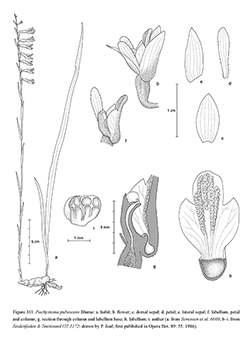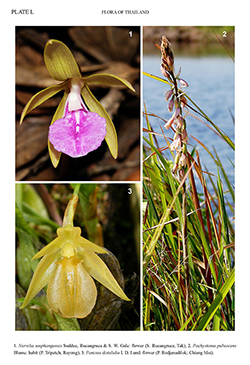e-Flora of Thailand
Volume 12 > Part 2 > Year 2014 > Page 576 > Orchidaceae > Pachystoma
Pachystoma pubescens Blumewfo-0000262221
Bijdr.: 376. 1825; Seidenf., Bull. Mus. Hist. Nat. (Paris), sér. 3, 71, Bot. 5: 139. 1972 (publ. 1973); Opera Bot. 89: 54, fig. 26. 1986; J.B.Comber, Orchids Java: 97 (incl. colour photo). 1990; Seidenf., Opera Bot. 114: 86. 1992; Seidenf. & J.J.Wood, Orchids Penins. Malays. Singap.: 159, fig. 69, t. 8b. 1992; J.B.Comber, Orchids Sumatra: 281 (incl. colour photo). 2001; N.Pearce & P.J.Cribb, Fl. Bhutan 3(3): 300, fig. 68. 2002; Pridgeon et al. (eds), Gen. Orchid. 4: 147, fig. 274.1, t. 42. 2005; S.C.Chen & J.J.Wood in Z. Wu et al. (eds), Fl. China 25: 286. 2009; Barretto et al., Wild Orchids Hong Kong: 405. 2011. Fig. 311; Plate L: 2.
Accepted Name : This is currently accepted.
Synonyms & Citations :
Description : Flowering shoots (26–)35–98 cm tall. Foliage leaves 1–2, linear-lanceolate, acute, 35–50 by 0.9–1.7 cm. Inflorescences semi-dense, pubescent though sometimes very sparsely so, often pink or purple; sterile bracts 8–18, erect or semi-erect, enveloping most of the stem, lanceolate oblong, acute, membranous, 3–9.7 cm long; rachis (4–)8‒20-flowered, (4–)6–25 cm long; floral bracts lanceolate, acute, membranous, 10–32 by 2–4 mm. Flowers usually pink or purplish pink, labellum often yellow or with yellow patch, flowers also recorded as cream-coloured or greenish-white, yellow or yellowish-green with violet markings. Sepals elliptic-lanceolate, subacute or acute, pubescent; dorsal sepal 8–12(–13.5) by 2.5–4.3 mm; lateral sepals gibbous at the base, 8–11(–12.5) by 2–4.6 mm. Petals linear-spathulate, obtuse to acuminate, pubescent, 8–12(–14) by 1.2–2(–2.8) mm. Labellum 3-lobed in the upper half, 7–11 by 5–6.5 mm; mid-lobe oblong, 2–5 by 1.8–4 mm; side lobes oblong-ovate, acute, suberect, 1.5–2.5(–3) by 1.5–2.2(–2.8) mm, inserted above the labellum middle; basal sac to 1 mm long; labellum ornaments of 3 or 5 tuberculate keels. Column slightly incurved, with prominent apical wings and a column foot, 5–7 mm long. Ovary (4–)6–9 mm long, distinct from the 2.5–5 mm long pedicel; both parts pubescent, green or violet. Capsule ellipsoid, pubescent, 8–10 by 4–5 mm.
Thailand : NORTHERN: Mae Hong Son, Chiang Mai, Sukhothai; NORTH-EASTERN: Phetchabun, Loei, Nong Khai, Sakon Nakhon; EASTERN: Chaiyaphum, Nakhon Ratchasima, Buri Ram, Surin, Ubon Ratchathani; SOUTH-WESTERN: Kanchanaburi; CENTRAL: Nakhon Nayok; SOUTH-EASTERN: Sa Kaeo, Prachin Buri, Rayong, Chanthaburi; PENINSULAR: Ranong, Surat Thani, Phangnga, Satun; UNSPECIFIED: Khao Yai NP [comprising parts of the provinces of Nakhon Ratchasima, Saraburi, Prachin Buri and Nakhon Nayok].
Distribution : India, ?Nepal, Bhutan, Bangladesh, Myanmar, Cambodia, Laos, Vietnam, S & SW China, Taiwan, the Philippines, Andaman Islands, Peninsular Malaysia, Sumatra, Java (type), Lesser Sunda Islands, Borneo, Sulawesi, Maluku, New Guinea, NE Australia (Northern Territory, Queensland), New Caledonia.
Ecology : Terrestrial in open grassy ground in often degraded dipterocarp, oak, pine, bamboo or evergreen broad-leaved forests or scrub, also in savanna and in swampy areas, sea level to 1,300 m alt. Recorded over sandstone and quartzite. Flowering: (December–)February– March(–May).
Vernacular : Wan hua khaoniao (ว่านหัวข้าวเหนียว); haeo cha khru (แห้วชะครู)(Central); mu-ni-ta-na (มุนิตานา)(Malay-Satun).
Notes: -The collection Kerr s.n. -P! appears to have been made in Khon Kaen Province in the north-east [locality hardly legible].
Plants growing in grass that is floating on water have been reported from Rayong (S. Watthana, pers. comm.). Interestingly, unlike typical specimens of Pachystoma pubescens, the plants of this ecological variant form prominent corms/pseudobulbs which are partly above-ground.


